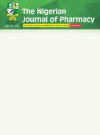Phytochemical and Antifungal screening of Jatropha curcas leaf extract in ointment formulations- A Preliminary study
Keywords:
Jatropha curcas, Antifungal, Inhibition zones, Extraction, PhytochemicalsAbstract
Background: Plants are rich sources of many natural products which have being extensively used for treatment of various infections. Jatropha curcas, a perennial plant belonging to Euphorbiacae family has been used medicinally to cure various diseases including skin infections. Toxicities and failure in treatment have been reported variously in literature to most synthetic dermatological formulations, hence there is the need to search for safe and effective alternatives. The present study aims at extracting Jatropha curcas leaves, formulating the extract into an ointment and evaluating the ointment.
Methods: Pulverized leaves of Jatropha curcas were extracted using methanol and the extract was later formulated into an ointment with paraffin ointment BPC as a base. The extract and the ointment at concentrations 0, 2.5, 5, 7.5 and 10% w/w were tested against Trichophyton tonsurans and Trichophyton interdigitale, common dermatophytes often implicated in skin infections. Whitfield ointment was used as a reference standard.
Results: The results showed the presence of flavonoids, saponins and tannins as secondary metabolites. The plant extract had mean inhibition zones of 12.00, 16.25 , 18.35 mm against Trichophyton interdigitale and 12.25, 18.35 , 24.50 mm against Trichophyton tonsurans (p=0.905) respectively at concentrations 5, 7.5, and 10.0% used for ointment formulations. The ointment formulations at all concentrations did not show any activity while Whitfield ointment a reference standard had inhibition zones of 36 .50 and 38.50 mm against the tested organisms respectively.
Conclusion: Notwithstanding the inhibitory failure of the ointment formulations, the extract exhibited a promising antifungal potentials.
References
Schmook B and Seralta-Peraza L. (1997). Jatropha. curcas: Distribution and uses in the Yucatan Peninsula of Mexico, In: Gübitz GM, Mittelbach M and Trabi M. (eds.) : Biofuels and Industrial products from Jatropha curcas. DBV Graz Press, Mexico. 53–57.
Gubitz GM, Mittelbech, M and Trabi M.(1999). Exploitation of tropical oil seed plant Jatropha curcas. L. Bioresour. Technol. 67: 73-82.
Mart’inez-Herrera J, Siddhuraju P, Francis G, D’ avila-Ort’iz G and Becker K. (2006).Chemical composition, antimetabolic constituents of Jatropha curcas L. from Mexico. Food Chem. 96: 80-89.
Duke JA. (1988). CRC Handbook of Medicinal Herbs 1st ed. CRC Press, Boca Raton, Florida .253-254.
Linnaeus C. (1753). Species plantarum. In: Jatropha. Impensis Laurentii Salvii, Stockhol. 1006-1007.
Katwal RPS and Soni PL. (2003). Biofuels: An opportunity for socioeconomic development and cleaner environment. Indian Forester. 129: 939-949.
Openshaw K. (2000). A review of Jatropha curcas: An oil plant of unfulfilled promise. Biomas Bioenergy. 19: 1-15.
Heller J. (1996). Physic Nut. Jatropha curcas L. Promoting the Conversation and use of Underutilized and Neglected crops. International plant Genetic Resources Institute, Rome.
Aiyelaagbe OO, Adeyeni BA, Fatunsin OF and Arimah BD. (2007). In vitro antimicrobial activity and phytochemical analysis of Jatropha curcas roots. Int. J. Pharmacol. 3(1): 106-110.
Chabra SC, Mahunnah RLA and Mshiu EN. (1990). Plants used in traditional medicine in Eastern Tanzania. III Angiosperms (Euophorbiaceae to Menispermaceae). Journal of Ethnopharmacology. 28: 255-258.
Staubman R, Manfred S, Alois H and Theodor K. (1999). A complex of 5- hydroxpyrrolidin-2-one and pyrimidine-2,-4dione isolated from Jatropha curcas. Phytochemistry. 50: 337-338.
Singh YN, Ikahiifo T, Panuve M and Slatter C. (1984).Folk medicine in Tongga. A study on the use of herbal medicines for obstetric and gynecological conditions and disorders. J. Ethnopharmacol. 12: 305-329.
Parveen BU, Shikha R and Ashawani K. (2007). Traditional uses of medicinal plants among the rural communities of Churu district in the Thar Desert, India. J. Ethnopharmacol.. 113: 387-399.
Thomas OO.(1989). Re-examination of the antimicrobial activities of Xylopia aethiopica, Carica papaya, Ocimum gratissimum and Jatropha curcas. Fitoterapia. 60: 147-155.
Fagbenro-Beyioku AF, Oyibo WA and Anuforom BC. (1998). Disinfectant and antiparasitic activities of Jatropha curcas. East Afri. Med. J. 75: 508-511.
Oliver-Bever B. (1986). Medicinal Plants in tropical West Africa. 2nd ed,Cambridge University Press, London. 84-89..
Sofowora A. (2008). Medicinal Plants and Traditional Medicine in Africa. Third edition, Ibadan: Spectrum Books Limited 4: 66-256.
Evans WC. (2009). Trease and Evans’ Pharmacognosy 16th Edition, Bailliere Tindall. London. 45-60
Igbinosa OO, Igbinosa EO and Aiyegoro OA. (2009). Antimicrobial activity and phytochemical screening of stem bark extracts form Jatropha curcas L. Afr. J. Pharm. Pharmacol. 3(2): 58-62.
Hodek P, Trefil P and Stiborova M. (2002). Flavonoids – Potent and versatile biologically active compounds interacting with cytochrome P450. Chemico-biol. Int. 139(1): 1-21.
Shimoda T. (2006). Salivary proteins as a defense against dietary tannis. J. Chem. Ecol. 32(6):1149-1163.

Downloads
Views | PDF Downloads:
713
/ 525


